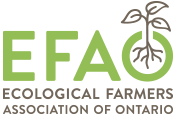Research Library
EFAO’s research library is an open access resource where you can find all of EFAO’s research protocols, reports and publications, and other on-farm research guides.
- The amount of forage consumed was the same, irrespective of standard or ultra high density grazing.
- Tony found no difference in pasture recovery between standard and ultra high density grazing.
- Tony will graze these areas in a similar way next year to see if a second year of a “hit and boost” has benefits.
Much of the flower seed being produced and used by cut flower growers across Canada is grown internationally in the Netherlands, Israel, and various South American and African countries. This means that varieties are not adapted to the Canadian climate and flower growers can’t support local seed houses. Jessica wanted to assess different varieties from local seed houses to find the best one for her farm, and she enlisted the help of other flower growers.
Key Findings
- There was not a detectable difference in plant quality among blush or white varieties.
- While there was not enough data to analyze statistically, Jessica recorded differences in bloom period and vase life. In doing so, she gained insight into the importance of these factors – especially in hot southern Ontario – for future variety trials of Sweet Peas.
With the goal of regenerative farming, Brent and Gillian want to minimize tillage for their organic salad greens production. To do this, they trialed tarps to kill residue between succession plantings and recorded the management needed to direct seed. They also tracked labour, including time moving and placing tarps and hand weeding.
Key Findings
- Tarping soil, without tilling before tarping, reduced tillage by 82% and resulted in faster growing crops.
- It also reduced total labour 60% for lettuce and spinach crops because of fewer weeds.
- It increased total labour by 65% for mustard greens, which do not require weeding.
Northern Ontario faces specific challenges compared to other parts of the province when it comes to seed production, including late springs and early frosts (as early as end of August), followed with a wet fall. The demand for lettuce and greens seed is high, but these growing conditions make producing lettuce seed outdoors very difficult. This means that northern seed producers cannot produce regionally adapted varieties. As a potential solution to lettuce seed production in northern Ontario, Peggy compared seed production in a hoop house and uncovered.
Key Findings
- In the hoop house, Peggy grew sellable lettuce seed from 4 of 5 varieties, and sales of the seeds would recoup hoop house material costs in 2.21 years.
- When grown uncovered, none of the 5 varieties produced viable seed.
- The “Fruition” or “pyramid” method, learned from Petra and Matthew at Fruition Seeds, where the head is trimmed like a pyramid such that leaves are usable but not sellable and;
- An alternative “Meadowlark” or “chop” method, learned from Beth and Nathan at Meadowlark Hearth Biodynamic Seeds, that removes the head in a way that it can be sold at winter or spring markets.
in southern Ontario during the 2023 season.
